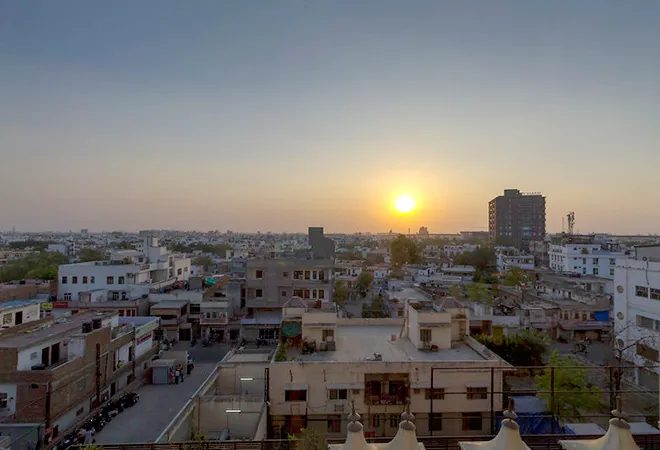-
CENTRES
Progammes & Centres
Location
The pandemic has highlighted both the increasing significance of cities in the larger national governance ecosystem as also exposed their vulnerabilities.

Image Source: © Mike Freedman/Flickr
The expenditures incurred to battle the COVID-19 pandemic has drained coffers of municipal bodies, and it has exposed the fragile financial structure of city governments across India.
The subsuming of octroi and local body tax (LBT) after the GST regime came into force in 2017 has aggravated the situation and made cities dependent on their respective state governments for compensating the losses. In Mumbai, this makes up for almost 35 percent of the Municipal Corporation of Greater Mumbai’s (MCGM) direct income source and about 17-20 percent of the total budget amount.
As financial resources available with cities further dwindle, it is time that the central government considers creating a fixed statutory city fund. Money could be allocated for such a fund from the GST collection, and could be routed by the Centre directly to the urban local body. The COVID pandemic has highlighted both the increasing significance of cities in the larger national governance ecosystem as also exposed their vulnerabilities. It might be therefore worthwhile to consider creating a municipal (finance) list just like a state and concurrent list in the constitution that could set aside funds to be diverted directly to cities.
"Money could be allocated for such a fund from the GST collection, and could be routed by the Centre directly to the urban local body."
The recommendation made by the Ministry of Urban Development (MOUD) in June 2015, asked for a 25 to 30 percent share for all urban local bodies in the state’s share of the GST. It spelt out how “GST will subsume most of the revenue sources of urban local bodies, thus depleting its finances.” In 2019, an ICRIER report on municipal finances also recommended an amendment “to provide sharing of the revenues from GST among all three levels of the government.”
The meeting of the GST Council last week brought to the fore how the GST collections are hit and states are demanding for compensation, for which the central government is also open to consider market borrowings. To prevent such a scenario in the future, a city statutory fund could underwrite the running of cities at all times.
In India, municipal revenues constitute just about one percent of the GDP, the corresponding figure is in the league of five percent for countries like South Africa, Poland and Brazil. There are 18 functions defined by the 74th Amendment of the Indian Constitution that cities have to perform. According to a 2011 High-Powered Committee Report on Infrastructure, cities are currently functioning with just about 20 percent of the actual money that they need to perform all these functions, and only 12 of the functions have a revenue stream.
"In India, municipal revenues constitute just about one percent of the GDP, the corresponding figure is in the league of five percent for countries like South Africa, Poland and Brazil."
Earlier this week, the MCGM revealed that it has spent ₹4.8 billion, i.e. over half of its contingency fund of ₹8.5 billion, towards its expenses on medical gear, food distribution and setting up infrastructure. It has predicted that this might surge further to ₹1.3 billion per month, forcing them to reconsider its 2020-21 budget allocations.
A similar situation has come up in Pune, where its revenue budget has dipped and it might face a liquidity crisis in the next six months. Its property tax receipts have been ₹1.45 billion as against ₹6 billion in the first 45 days of the year. In a bid to increase collections, several corporations, like that of Bangalore and Ahmedabad have also introduced rebates for property tax payers.
While, corporations like Mumbai have money parked in bank deposits that could be used to run the city, it will be difficult for cities like Pune and especially those in poorer states such as Madhya Pradesh or Rajasthan, which are grappling with the pandemic, to weigh out the losses. Even in the case of richer corporations like Mumbai, the deposits have already been allocated for infrastructure projects like the Mumbai coastal road, which should ideally have been done under the purview and through the state government, since such works do not fall under the mandated functions of the municipal corporation.
"The central government has made a combined allocation of ₹980 billion for the Smart Cities Mission and the Atal Mission for Rejuvenation and Urban Transformation."
In 2011, the High-Powered Committee in its ‘Report on Indian Urban Infrastructure and Services’ looked at the revenues assigned to municipal bodies through the 12th Schedule of the 74th Amendment, and recommended a municipal finance list of revenue sources as an alternative to octroi. Accordingly, it called for instituting revenue-sharing taxes, including all taxes on goods and services levied by the state government, which is now GST. In the United States, city municipalities have access to income tax, excise tax, value added tax, goods and services tax.
Similarly, in South African cities, there are ‘equalisation grants’ which municipal corporations can access for any development works that they wish to carry out. While the constitution specifies that the local government is responsible for the provision of basic services like water, sanitation, electricity, sewerage, solid waste management and roads, apart from ‘user charges’ which is their main revenue source, they are also entitled to an ‘equitable share’ of the national revenue.
Some argue that a significant portion of funds are allotted for city regeneration projects through central government schemes. The central government has made a combined allocation of ₹980 billion for the Smart Cities Mission and the Atal Mission for Rejuvenation and Urban Transformation (AMRUT). While the Smart Cities Mission aims at creating 100 smart cities in India, the AMRUT concentrates on infrastructure projects of water supply, sewerage, non-motorable transport and green spaces in 500 cities across India.
"While the Smart Cities Mission aims at creating 100 smart cities in India, the AMRUT concentrates on infrastructure projects of water supply, sewerage, non-motorable transport and green spaces in 500 cities across India."
However, these funds, which form about 5.3 percent of municipal revenue, usually come with several conditions and require minimum delivery standards for municipal corporations to qualify. India has a total of 7,935 cities and census towns. It is clear that not all will benefit from these schemes, leading to inequalities of urbanisation.
It is time that we take the financial crisis faced by cities seriously and constitute an unconditional, annual and formula-driven statutory fund to finance all their functional and infrastructure needs.
The views expressed above belong to the author(s). ORF research and analyses now available on Telegram! Click here to access our curated content — blogs, longforms and interviews.

Sayli UdasMankikar was a Senior Fellow with the ORF's political economy programme. She works on issues related to sustainable urbanisation with special focus on urban ...
Read More +